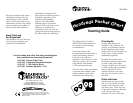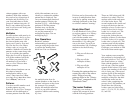
column patterns with even
numbers! With older students,
this can lead to a discussion of
multiples and divisibility. Use
your even/odd chart to divide
groups of students into pairs. If
there is one student left over the
total is odd, not even! Verify your
total on the chart.
Multiples
Provide students with practice in
counting by twos, threes or fives.
Place cards numbered 1-100 in
the chart with the same side
facing out. Count by fives and
flip over the five, ten, fifteen,
twenty cards, as you say the
numbers. Students will notice the
patterns as they count along with
you. In a column, the numbers
below the five will be flipped, as
will all the numbers below the
ten. When you count by five,
all numbers will end with a
zero or a five! Discuss other
number patterns.
More advanced students can use
this chart to learn the
multiplication tables as you
count: “One times five is five,
two times five is ten, three times
five is fifteen,” and so on.
Patterns
Use the reversible number cards
to make patterns on your
Hundreds Pocket Chart. Younger
students will be challenged to
recreate patterns from the chart,
while older students can try to
identify or continue the number
pattern that is displayed. You
can even demonstrate fractional
number patterns! Display the
fractions , , … and challenge
students to find the pattern.
Students may say that the
denominator is multiplied by
six and the numerator is
multiplied by three. You are
multiplying by !
Four Operations
Reinforce students'
understanding of operational
concepts using the pocket chart
to explore the number facts
below ten. You can illustrate
the multiplication facts for
certain numbers on the chart for
students’ reference as they learn
the concepts. For example,
display the multiplication facts
for six as you teach students
repetitive addition and counting
by sixes.
Division can be discussed as the
inverse of multiplication. Start
each day by putting warm-up or
challenge problems on the chart
to reinforce students’ learning!
Ninety-Nine Chart
Use the Hundreds Pocket Chart
to explore patterns in a “Ninety-
Nine Chart.” Make a number
card with the number zero.
Encourage students to rearrange
the numbers 1-99, adding the
zero to the chart. You will not
need the number 100. Challenge
students to do the following
tasks:
• Flip over all the even
numbers.
• Flip over all the
multiples of three.
• Flip over all the
multiples of five.
Examine the patterns that are
created by each of the above
tasks. Discuss how the
patterns differ in the “Ninety-
Nine Chart” compared to the
“Hundreds Chart.”
The Locker Problem
Challenge your students to
explore the concept of factors
with the following problem:
There are 100 lockers and 100
students in a school. The first
student walks inside and opens
all of the locker doors. The
second student walks inside and
reverses all the doors that are
multiples of two. (Locker two is
closed, locker four is closed,
locker six is closed, etc.) The
third student walks in and
reverses the lockers that are
multiples of three. (Locker three
is closed, locker six is opened,
locker nine is closed, etc.) This
continues until all the students
have walked into the building.
Challenge your students to find
the lockers that remain open.
Your students can accomplish
this problem by designating all
the open lockers as “red” and all
the closed lockers as “white.”
Start with the numbers 1-100,
red side out. (The first student
opened all the lockers.) Flip over
all the even numbers so the white
side is facing out. (The second
student closed all the multiples
of two.) Then, flip over all the
multiples of three for the third
student that walks into the
school. After completing the
process for all 100 students you
should have the following
lockers open (red side facing
out): 1, 4, 9, 16, 25, 36, 49, 64,
81, and 100.




